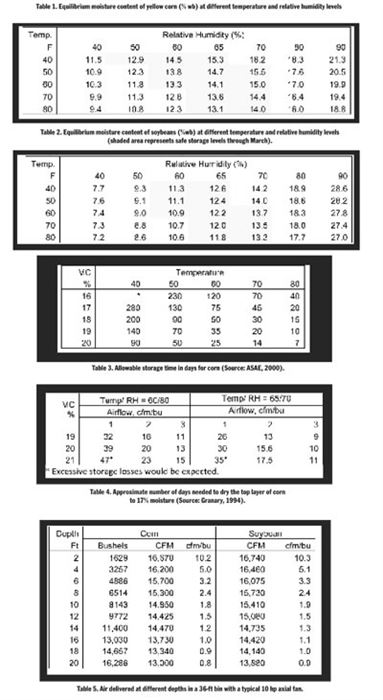Drying The 2009 Corn And Soybean Crops
LEXINGTON, KY.
The cool wet fall has drastically delayed normal field drying of corn and soybeans and will add to operating costs for all drying systems. High temperature automatic batch and continuous flow dryers will require 10 to 15 percent more energy per bushel because of the cool, humid air which has less moisture holding capacity than normally seen in the fall. Producers who usually rely on natural air drying in the bin may want to consider installing a low temperature burner or using a space heater to add between 5 to 10 degrees to the outside air. This will lower the humidity of humid/night time air by roughly 10 to 20 percent, respectively, and speed up drying. If too much heat is added, grain in the bottom of the bin will be overdried, which adds considerably to drying costs and market weight loss.

Table 1. Equilibrium moisture content of yellow corn (% wb) at different temperature and relative humidity levels
Table 2. Equilibrium moisture content of soybeans (%wb) at different
temperature and relative humidity levels (shaded area represents safe
storage levels through March).
Table 3. Allowable storage time in days for corn (Source: ASAE, 2000).
Table 4. Approximate number of days needed to dry the top layer of corn to 17% moisture (Source: Granary, 1994).
Table 5. Air delivered at different depths in a 36-ft bin with a typical 10 hp axial fan.
Drying limits for corn and soybeans are shown in Table 1 and 2, respectively. These are the moisture levels each grain will reach after sufficient exposure to the air conditions shown. For example, at 50 degrees and 70 percent humidity, corn will reach 15.5 percent moisture and soybeans will reach 14.0 percent moisture. Tracking the average weather conditions during fan operation is important for maintaining appropriate grain moistures within the bin.
Two other pieces of useful information to consider during harvest are the allowable storage time (Table 3) and the amount of time required to dry corn (Table 4). Cooler temperatures add to storage life, which has been about the only saving grace this fall. Use the information from tables 1 and 2 to predict similar conditions for soybeans. For example at 60 degrees and 70 percent humidity, soybeans at 13.7 percent moisture have a similar storage time as corn at 15.0 percent moisture, which is 120 days. Note in Table 4 that for some drying situations the amount of time required to dry the crop can exceed safe limits with the poor weather conditions typical in November and December.
Another important piece of information needed to manage natural air drying systems is the amount of air the fan can provide for different depths in a bin. Table 5 shows an example of a typical 10 horsepower axial fan on a 36 feet diameter bin for both corn and soybeans. In this case, airflows of 3, 2 and 1 cfm/bu are possible at corn depths of 6.5, 9 and 16 feet, respectively, and soybean depths of 6.7, 9.6, and 18, respectively.
The relevant point here is that corn at 20 percent moisture and 60 degrees will only have about 25 days to dry before some losses occur, so grain depths must be fairly shallow to provide enough airflow (greater than 2 cfm/bu) to dry the crop before sprouting or mold damage occurs. In the example given, once the top layer of corn is dried to 17 percent moisture (18 percent for soybeans), an 8-ft layer can be added to maintain an airflow of 2 cfm/bu. Cool all grains to 35 to 40 degrees to add storage life and consider either selling before next spring or finish drying then.
More information on different grain drying systems and their efficient operation is provided in Chapter 10 of the publication ID-139 “A Comprehensive Guide to Corn Management in Kentucky” (www.ca.uky.edu/agc/pubs/id/id139/id139.htm). Additionally, a list of publications that describe specific drying systems is provided in the document. These may be ordered from county extension offices or by calling Joyce Peel at 859- 257-3000 x 111. Δ
DR. SAM MCNEILL: Biosystems And Agricultural Department, University of Kentucky